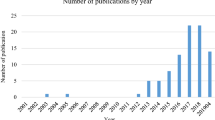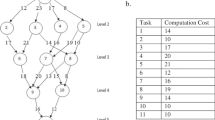Abstract
Electromagnetism-like mechanism (EM) is an emerging and potential metaheuristic based on the attraction and repulsion forces in electromagnetic theory. EMs have been successfully applied to scheduling problems. However, few studies have been conducted regarding the application of EMs in parallel machine scheduling problems. We developed a new EM to solve identical parallel machine scheduling problems under the consideration of family setup times. The objective was to minimize the total weighted flow time. The new EM comprises a matrix representation, a discrete distance measurement, and a proposed attraction-repulsion operator to effectively search for a near-optimal solution. The experiment results indicated that the new EM renewed nearly all best-known solutions in the benchmark problems, and was superior to a genetic algorithm.
Similar content being viewed by others
References
Lin HT, Liao CJ (2003) A case study in a two-stage hybrid flow shop with setup time and dedicated machines. Int J Prod Econ 86:133–143
Jin F, Song S, Wu C (2009) A simulated annealing algorithm for single machine scheduling problems with family setups. Comput Oper Res 36:2133–2138
Allahverdi A, Ng CT, Cheng TCE, Kovalyov MY (2008) A survey of scheduling problems with setup times or costs. Eur J Oper Res 187:985–1032
Graham RL, Lawler EL, Lenstra JK, Rinnooy Kan AHG (1979) Optimization and approximation in deterministic sequencing and scheduling: a survey. Annals of Discrete Mathematics 5:287–326
Dunstall S, Wirth A (2005) Heuristic methods for the identical parallel machine flowtime problem with set-up times. Comput Oper Res 32:2479–2491
Liao CJ, Chao CW, Chen LC (2012) An improved heuristic for parallel machine weighted flowtime scheduling with family set-up times. Computers & Mathematics with Applications 63:110–117
Webster S, Azizoglu M (2001) Dynamic programming algorithms for scheduling parallel machines with family setup times. Comput Oper Res 28:127–137
Azizoglu M, Webster S (2003) Scheduling parallel machines to minimize weighted flowtime with family set-up times. Int J Prod Res 41:1199–1215
Chen ZL, Powell WB (2003) Exact algorithms for scheduling multiple families of jobs on parallel machines. Nav Res Logist 50:823–840
Dunstall S, Wirth A (2005) A comparison of branch-and bound algorithms for a family scheduling problem with identical parallel machines. Eur J Oper Res 167:283–296
Birbil SI, Fang SC (2003) An electromagnetism-like mechanism for global optimization. J Glob Optim 25:263–282
Debels D, Reyck BD, Leus R, Vanhoucke M (2006) A hybrid scatter search/ electromagnetism meta-heuristic for project scheduling. Eur J Oper Res 169:638–653
Godinho P, Branco FG (2012) Adaptive policies for multi-mode project scheduling under uncertainty. Eur J Oper Res 216:553–562
Gao L, Zhang C, Li X, Wang L (2014) Discrete electromagnetism-like mechanism algorithm for assembly sequences planning. Int J Prod Res 52:3485–3503
Mirabi M (2014) A hybrid electromagnetism algorithm for multi-depot periodic vehicle routing problem. Int J Adv Manuf Technol 71:509–518
Chang PC, Chen SH, Fan CY (2009) A hybrid electromagnetism-like algorithm for single machine scheduling problem. Expert Syst Appl 36:1259–1267
Chao CW, Liao CJ (2012) A discrete electromagnetism-like mechanism for single machine total weighted tardiness problem with sequence-dependent setup times. Appl Soft Comput 12:3079–3087
Tseng CT, Lu WT (2011) A discrete electromagnetism-like mechanism for parallel machine scheduling under a grade of service provision. In: Conference on Chinese institute of industrial engineers.
Khalili M (2014) A multi-objective electromagnetism algorithm for a bi-objective hybrid no-wait flowshop scheduling problem. Int J Adv Manuf Technol 70:1591–1601
Naderi B, Moghaddam RT, Khalili M (2010) Electromagnetism-like mechanism and simulated annealing algorithms for flowshop scheduling problems minimizing the total weighted tardiness and makespan. Knowl-Based Syst 23:77–85
Yan HS, Wan XQ, Xiong FL (2014) A hybrid electromagnetism-like algorithm for two-stage assembly flow shop scheduling problem. Int J Prod Res 52:5626–5639
Tavakkoli-Moghaddam R, Khalili M, Naderi B (2009) A hybridization of simulated annealing and electromagnetic-like mechanism for job shop problems with machine availability and sequence-dependent setup times to minimize total weighted tardiness. Soft Comput 13:995–1006
Roshanaei V, Balagh AKG, Esfahani MMS, Vahdani B (2010) A mixed-integer linear programming model along with an electromagnetism-like algorithm for scheduling job shop production system with sequence-dependent set-up times. Int J Adv Manuf Technol 47:783–793
Jou C (2005) A genetic algorithm with sub-indexed partitioning genes and its application to production scheduling of parallel machines. Comput Ind Eng 48:39–54
Author information
Authors and Affiliations
Corresponding author
Rights and permissions
About this article
Cite this article
Tseng, CT., Lee, CH. A new electromagnetism-like mechanism for identical parallel machine scheduling with family setup times. Int J Adv Manuf Technol 89, 1865–1874 (2017). https://doi.org/10.1007/s00170-016-9226-8
Received:
Accepted:
Published:
Issue Date:
DOI: https://doi.org/10.1007/s00170-016-9226-8




